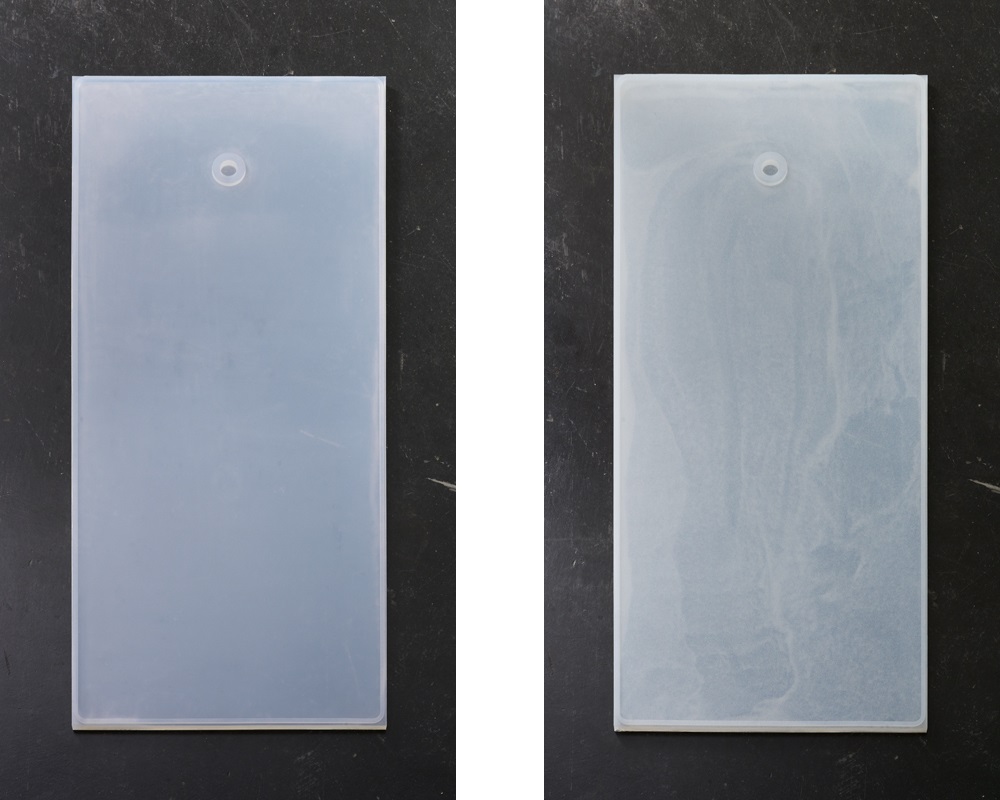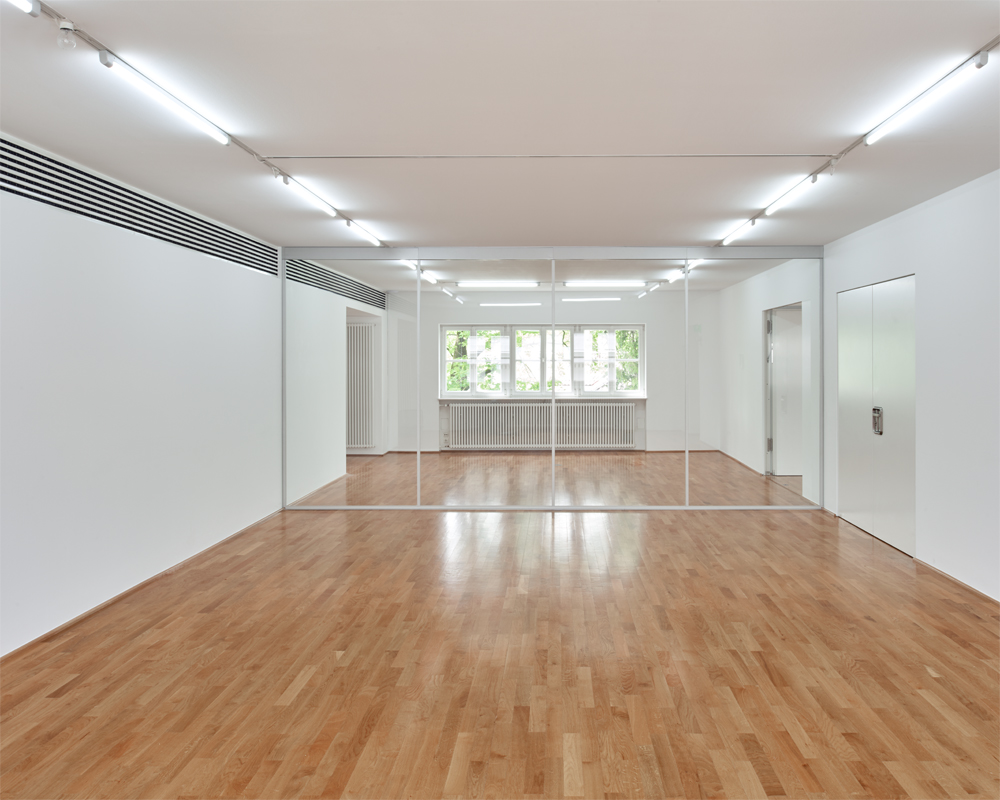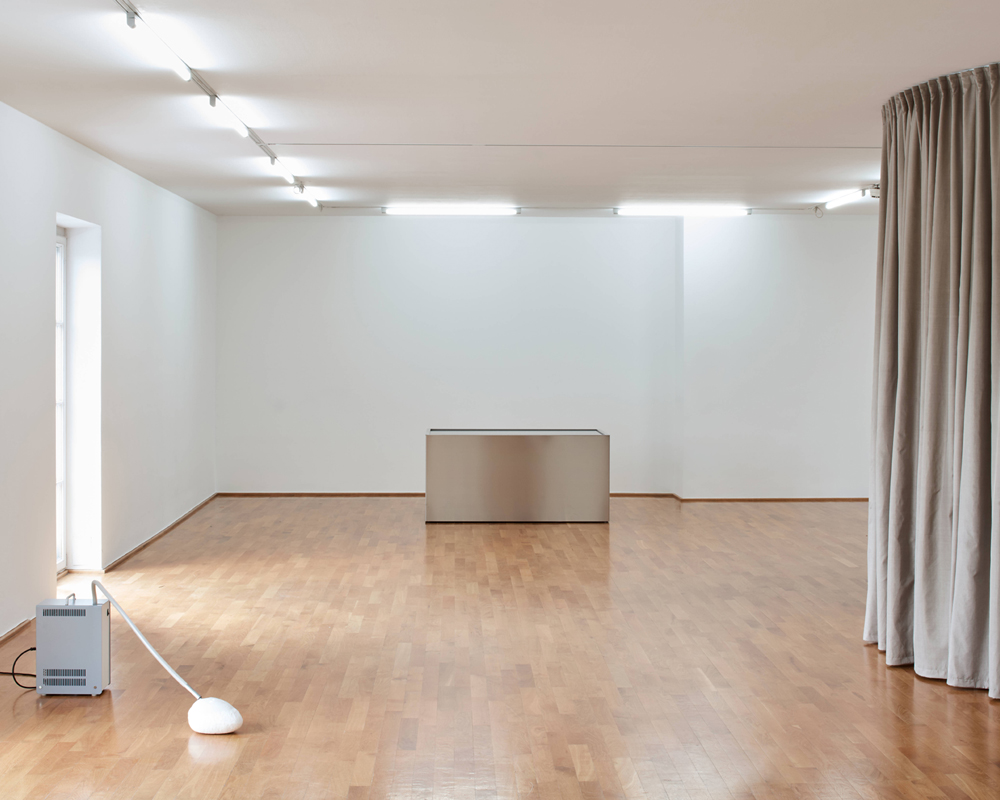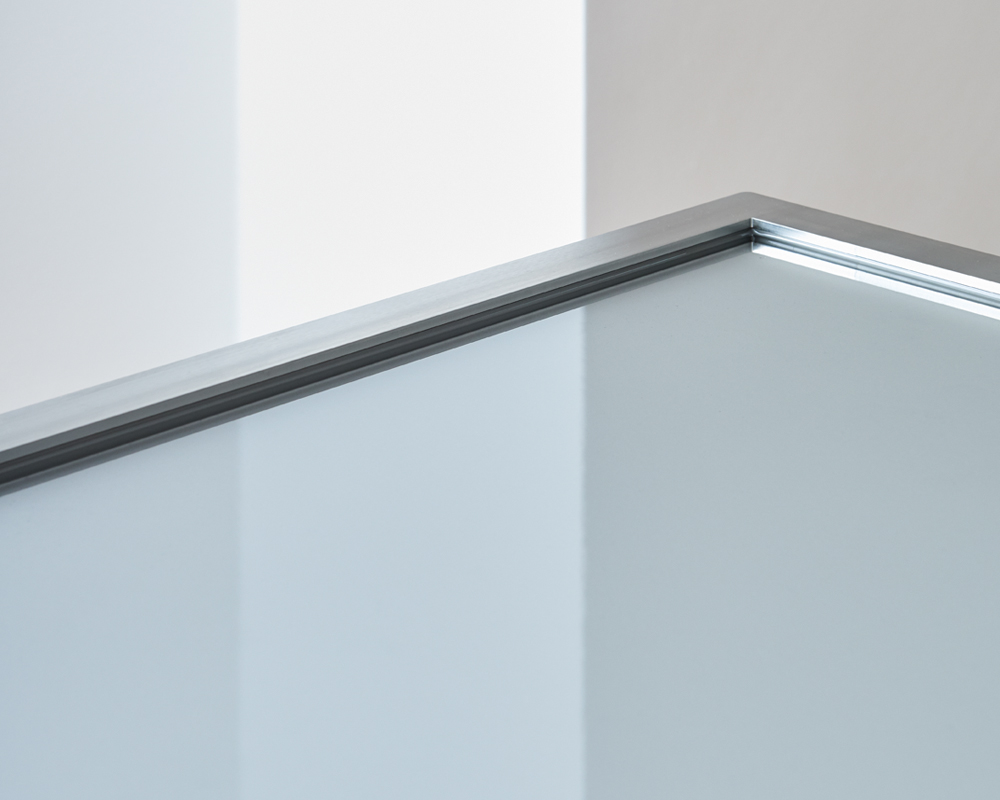All the Wrong Lessons, Phantom, Prothesis, Traveller, Study for a Head, Monument, Untitled (Necklace), Parallels (Milk), Less Work for Mother, Doors (from Memory), Empire, Where I Lived, and What I Lived For, How to Disappear Completely, Cabin, Untitled (Fountain), Untitled (Pendulum), Wire Mother, Father Sings, Intra, 12 Hz, 37°C, Ghost, Garda

Less Work for Mother
Museum Villa Stuck Munich (solo)
Curator: Verena Hein
19 June — 21 October 2018
Opening: Monday, 18 June 2018, 7 p.m.
A catalogue (German / English) has been published at Distanz Verlag Berlin, with contributions by Christian Hartard, Florian Pumhösl and Verena Hein, design: Bernd Kuchenbeiser.
→ Catalogue
With the support of Alexander-Tutsek-Stiftung, Erwin-und-Gisela-von-Steiner-Stiftung, Prinzregent-Luitpold-Stiftung.
/
The starting point for the series of works shown at Villa Stuck was research into the biography of my great-aunt Barbara Hartard, who—a patient at the Eglfing (Haar) sanatorium near Munich since 1924—became a victim of Nazi ›euthanasia‹ in the late summer of 1940 at the Hartheim Castle killing centre near Linz (on her biography: → Wo ich hingehe, geht Sie nichts an, also published in the exhibition catalogue). The extermination of ›life unworthy of life‹ in the ›Third Reich‹ was the perversion of eugenic ideas which had been discussed in Germany since the beginning of the 20th century. For the National Socialists, the euthanasia murders, for which gas chambers were used for the first time, were both an experimental field and a blueprint for the industrialised killing in the Holocaust.
The works in the exhibition—objects, graphic, video, site-specific installations—do not attempt to document or illustrate this complex historical field or an individual fate. Rather, they strive to find open formulations for basic experiences of fear, loss or wounding. Nevertheless, there are references to historical events, visible and less visible ones: Dimensions and choice of materials; motifs of corporeality and latent violence, pain and possible healing; the cool atmosphere of a life maintained by apparatus. A current-carrying curtain, viscous industrial wax or gold dissolved in acid are stores of energy and memory that give a place to what no longer exists. They note what has faded and disappeared. The nervous trembling of window glass, images of milk boiling over, things made of porcelain and textiles are also protocols of what once was or might have been. By evoking domestic activities in the former servants’ quarters of Villa Stuck, they lay ambiguous traces into the past.
/
100 seconds
Video interview on the exhibition »Less Work for Mother«:
/
Reviews
→ Quirin Brunnmeier, Türen der Erinnerung. Christian Hartard in der Villa Stuck, Super Paper Nr. 106, August 2018 and Gallerytalk, 23 August 2018
→ Roberta De Righi, Was mit Tante Babette geschah, Abendzeitung München, 9 July 2018
→ Alexander Altmann, Erhellende Absurdität. José Antonio Suárez Londoños „Almanach“ und Installationen von Christian Hartard in der Münchner Villa Stuck, Bayerische Staatszeitung, 3 August 2018
→ Die Villa Stuck zeigt wieder zwei faszinierende Ausstellungen, münchen.tv, 5 July 2018
/
Programme
Friday, 20 July 2018, 8 p.m.
Concert with Michaela Meise
Friday, 5 October 2018, 6 —10 p.m.
Friday Late
Thursday, 18 October 2018, 7 p.m.
Thomas Hirschhorn: Never Give Up The Spot (Opening)
Saturday, 20 October 2018, 7 p.m.—2 a.m.
Lange Nacht der Museen
/
exhibition documentation
Photos: Jann Averwerser
/
First cabinet

/
Less Work for Mother
2018
Pigment print on paper from an original photograph by Karl Schuhmann (1940 / 41), passe-partout, visible cutout 7.8 x 5 cm, framed
22 x 33.5 cm
From 1940 on, Hartheim castle near Linz functioned as one of the six extermination centres involved in the Nazi euthanasia programme. In these centres, people with physical, mental and psychological impairments were systematically killed. By the official end of the programme known as ›Action T4‹ in 1941, over 18,000 patients from German and Austrian psychiatric and mental health care facilities had been murdered in Hartheim alone. Shortly after the Hartheim Extermination Centre was established, a neighbor of the castle secretly photographed the smoking crematorium chimney. This picture is the only document that shows the killing machinery in operation. In the exhibition, the largest portion of the image is concealed by the passe-partout; only the smoke from burning bodies streaming out of the chimney remains visible in the cut-out.

/
Doors (from Memory)
2018
Silicone rubber
Each 1.7 x 75 x 165 cm
The gas chamber in Hartheim Castle was located between an examination room—from which victims, in groups of thirty to sixty people, were brought to be gassed—and an equipment room containing an iron pipe which led into the gas chamber and was used to introduce the carbon monoxide. According to witness Adam Golebskiʼs recollections, both sides of the chamber had a door made of ›iron, sealed with rubber and with massive latches; in the door was a small, round peephole.‹ According to a witness statement from the mason Erwin Lambert, two doors were built, the same as ›used for air-raid shelters‹, thus presumably standard bunker doors. To cover their tracks, in 1944/45 the doors were removed and the passages were closed. Excavation work later established that the dimensions of the walled-in doorways between the gas chamber and equipment room corresponded to the DIN 4104 pre-standard, the standardised norm for ›gas-tight rooms‹. The two castings of soft rubber are based on these dimensions.


/
Parallels (Milk)
2018
Two videos b/w, each in a 9 min loop, two monitors each 46.5 x 59 x 49 cm
Both monitors appear to show the same image. In reality, there is a millisecond shift between the two scenes. Two new sequences, each half as long as the initial film made with a high-speed camera, were produced by putting the individual images of the original into two separate films. Because the changes between two images in rapid succession cannot be discerned by the eye, two visually identical films emerge that are nonetheless based on non-identical footage.

/
Second cabinet

Phantom
2018
Laminated glass, anodised aluminum, electro-dynamic exciter, amplifier, audio file
268 x 550 cm
Four panes of window glass in metal frames form a floor-to-ceiling partition straight down the exhibition room. They are set in vibration by electro-dynamic exciters and produce an uneven, nervous clanging in the process.

/
Passage to the third cabinet

Untitled (Necklace)
2018
Fine gold 999.9 dissolved in acid as chloroauric acid (HAuCl4), blown glass, setting of rhodium-plated silver, 5 x 1.7 cm (diametre), fabric cord
Gold is dissolved in aqua regia, a mixture of hydrochloric acid and nitric acid, until the saturation limit. The name of the acid (›aqua regia‹) is derived from its ability to dissolve precious metals gold and platinum. Gold produces chloroauric acid. Glass is one of the few materials that is not affected by aqua regia.

/
Third cabinet

/
Monument
2018
Stainless steel, heating system, paraffin wax
70 x 150 x 90 cm
Wax is melted in a flat heated steel tank to form a liquid mass.


/
Prothesis
2018
Polished steel tube, iodine solution (iodine-potassium iodine solution, also known as Lugolʼs solution), pumping system
Overall length 725 cm
Iodine solution flows through a circulating system made of steel tubes.


/
Study for a Head
2018
Glazed ceramic, approx. 13.5 x 16 x 21 cm, coolant, immersion cooler, cooling unit, 38.5 x 18 x 27.5 cm
The hollow ceramic mold of the head of a tailorʼs dummy is cooled from the inside to below freezing point by a cooling unit. A fine layer of frost forms on the surface.


/
Traveller
2018
Silver threads, cotton fabric, electric current, grounding, metal track
268 x 630 cm (perimetre)
A curtain that has an electrically conductive surface composed of silver threads is connected to a power source.

/
All the Wrong Lessons
2018
Felt-tip pen on paper, 19 x 14.8 cm (drawings by Bernhard Hartard), metal casket made of galvanised sheet steel, 20 x 16 x 2.4 cm, magnets
My father attempts to draw a circle freehand that is as perfect as possible. I have asked my father to produce a page every day during the duration of the exhibition and to send it by post to the museum. The drawing is replaced daily.
